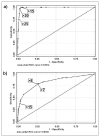Major trauma and the injury severity score--where should we set the bar?
- PMID: 18184482
- PMCID: PMC3217501
Major trauma and the injury severity score--where should we set the bar?
Abstract
Major trauma is commonly defined using an Injury Severity Score (ISS) threshold of 15. Since this threshold was formulated, there have been significant developments in both the Abbreviated Injury Scale underlying the ISS, and trauma management techniques, both in the preventive and acute-care phases of trauma management. This study assesses whether this ISS threshold is appropriate when evaluating both mortality, and hospital-based indicators of morbidity, in a paediatric population using a large hospital trauma registry. Other registries and datasets using ISS >15 as an inclusion criterion may exclude a substantial body of data relating to significantly morbid trauma patients.
Figures


Similar articles
-
Inclusion of 'minor' trauma cases provides a better estimate of the total burden of injury: Queensland Trauma Registry provides a unique perspective.Injury. 2014 Aug;45(8):1236-41. doi: 10.1016/j.injury.2014.03.023. Epub 2014 Apr 16. Injury. 2014. PMID: 24838189
-
Defining major trauma using the 2008 Abbreviated Injury Scale.Injury. 2016 Jan;47(1):109-15. doi: 10.1016/j.injury.2015.07.003. Epub 2015 Jul 10. Injury. 2016. PMID: 26283084 Review.
-
Correlating injury severity scores and major trauma volume using a state-wide in-patient administrative dataset linked to trauma registry data-A retrospective analysis from New South Wales Australia.Injury. 2020 Jan;51(1):109-113. doi: 10.1016/j.injury.2019.09.022. Epub 2019 Sep 13. Injury. 2020. PMID: 31547965
-
The value of the injury severity score in pediatric trauma: Time for a new definition of severe injury?J Trauma Acute Care Surg. 2017 Jun;82(6):995-1001. doi: 10.1097/TA.0000000000001440. J Trauma Acute Care Surg. 2017. PMID: 28328674 Free PMC article.
-
[Do we need trauma scoring in emergency medicine?].Anaesthesist. 1994 Jun;43(6):376-84. doi: 10.1007/s001010050070. Anaesthesist. 1994. PMID: 8048772 Review. German.
Cited by
-
The definition of major trauma using different revisions of the abbreviated injury scale.Scand J Trauma Resusc Emerg Med. 2021 May 27;29(1):71. doi: 10.1186/s13049-021-00873-7. Scand J Trauma Resusc Emerg Med. 2021. PMID: 34044857 Free PMC article.
-
Injury severity data for front and second row passengers in frontal crashes.Data Brief. 2016 Mar 17;7:839-43. doi: 10.1016/j.dib.2016.03.046. eCollection 2016 Jun. Data Brief. 2016. PMID: 27077084 Free PMC article.
-
The clinical characteristics and management of paediatric pelvic fractures: a changing landscape based on skeletal maturity.Eur J Trauma Emerg Surg. 2023 Feb;49(1):559-570. doi: 10.1007/s00068-022-02108-5. Epub 2022 Oct 3. Eur J Trauma Emerg Surg. 2023. PMID: 36190546 Free PMC article.
-
Intracranial Injury Among Children with Abuse-Related Long Bone Fractures.J Emerg Med. 2020 Nov;59(5):735-743. doi: 10.1016/j.jemermed.2020.06.006. Epub 2020 Jul 16. J Emerg Med. 2020. PMID: 32682640 Free PMC article.
-
Settlement Is at the End-Common Trauma Scores Require a Critical Reassessment Due to the Possible Dynamics of Traumatic Brain Injuries in Patients' Clinical Course.J Clin Med. 2024 Jun 5;13(11):3333. doi: 10.3390/jcm13113333. J Clin Med. 2024. PMID: 38893044 Free PMC article.
References
-
- Aharonson-Daniel L, Giveon A, Stein M, et al. Different AIS triplets: different mortality predictions in identical ISS and NISS. J Trauma. 2006;61:711–717. - PubMed
-
- Baker SP, O’Neill B, Haddon W, et al. The Injury Severity Score: a method for describing patients with multiple injuries and evaluating emergency care. J Trauma. 1974;14:187–196. - PubMed
-
- Balogh ZJ, Varga E, Tomka J, et al. The New Injury Severity Score is a better predictor of extended hospitalization and intensive care unit admission than the Injury Severity Score in patients with multiple orthopaedic injuries. J Orthop Trauma. 2003;17:508–512. - PubMed
-
- Baxt WG, Upenieks V. The lack of full correlation between the Injury Severity Score and the resource needs of injured patients. Ann Emerg Med. 1990;19:1396–1400. - PubMed
-
- Boyd CR, Tolson MA, Copes WS. Evaluating trauma care: the TRISS method. J Trauma. 1987;27:370–378. - PubMed
MeSH terms
LinkOut - more resources
Full Text Sources
Medical
